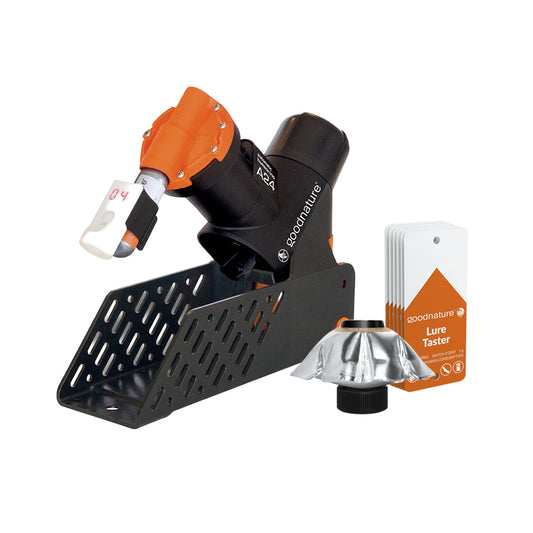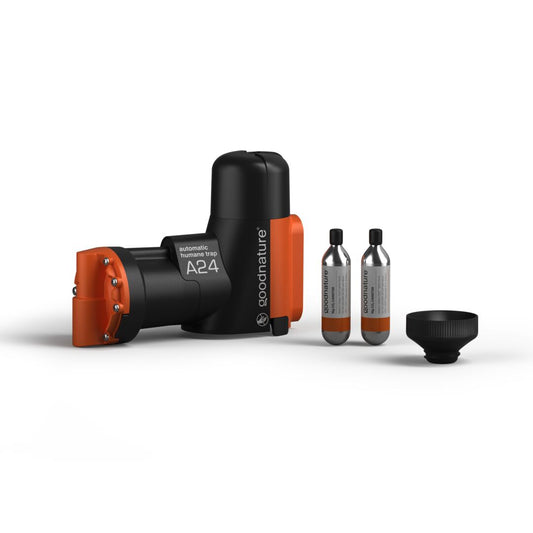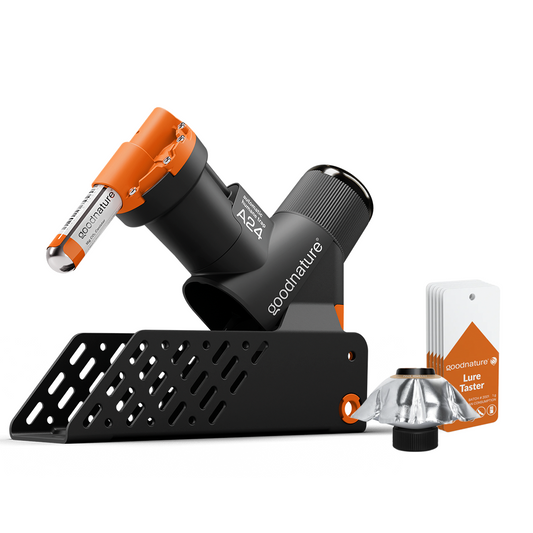
We were fortunate enough to sit down with Andrew Burress from Natura Pest Control who's team caught 39 mice in one night using Goodnature Traps! Natura Pest Control operates out of the Reno/Sparks area in Nevada. The area has had a considerable rise in rodent activity as urban development continues to naturally displace rats & miceF. Andrew talked to us about the challenges of working in the area as well as how using Goodnature™ Traps has changed the way his team works!
Automatic Trap: Hi, Andrew. Thank you for joining us today. Why don't you start off by telling us a little bit about yourself about Natura PC?
AB: Of course. Thanks, obviously again for having me, I've been doing/selling pest control since 2010. I started in door-to-door sales for a company in California, sold there for four years. After selling, I moved more into the service side of things, and really enjoyed it and sort of found my niche and what I wanted to do. Since then, I've worked with several other companies, like Clark Pest Control in California, now there's Terminix, before starting my own pest control company here in Reno, called Natura Pest Control.
We operate out of the Reno-Sparks area. We also cover Carson City now. You know, we've officially been a business here since early 2017, so we're still pretty darn new in the area, but we love the area here and all that it has to offer, in not just pest control but obviously the wonderful people and the area.
Automatic Trap: The Reno-Sparks area produces pretty favorable conditions for pests. You've got a mild climate and moisture throughout the year, and on your website, you even call the area an ideal breeding ground. What are some of the challenges of working in a climate like Reno?
AB: When you're in an area that is high desert like we are, you deal with a type of pest that is adapted to the environment. Bugs have an amazing ability to adapt to the weather conditions, and with Reno experiencing four different seasons throughout the year, you deal with invaders much more often than you would when have an area that's warm all year long, like Southern California.
So, when you get a sudden influx of climate and moisture, you have more frequent movements in bug activity from outdoors to indoors. With this type of environment you also deal with the longevity of the product, you know, lasting as long as you need it to. So, year after year, it's important to stay up on current trends in the industry, and also product always stay one step ahead of the bugs.
Which gets interesting when you have add the climate to the equation, and not just the natural ability for the bugs to adapt. You know, it makes for a challenging area for really good pest control.

Automatic Trap: What would you say is unique about Natura Pest Control and what you have to offer your clients?
AB: Like I mentioned before, I had the opportunity to work for a lot of different companies in the industry, through the years of selling and servicing. I felt like I had an ability to see sort of where there were big gaps in the services offered to customers. One of those main things is the overhaul and the usage of product.
At Natura, we don't try to simply just promise that they'll not see bugs, but more importantly, we try to obviously make sure and ensure that, and what we do to do that is overhaul our products every other year to make sure that there's no cross-resistance built up on customers' properties.
You know, so it's real important to stay up on trends like that and adapt your product to the service and the climate, because obviously, bugs are continuously doing that throughout the year.
Automatic Trap: what is the most common pest that you deal with?
AB: Any market you go into, I think ants and spiders will always be the top pest that you deal with. Here in Reno-Sparks area, though, we also deal with a ton of rodents.
New neighborhoods are being built higher and higher into the hills. Which naturally displace the rodent population that's already established in that area. In Reno, I'd say we do something rodent-related for at least half the customer base that we have.
And then obviously, seasonally you deal with a lot of ants in the spring, summer, and then mid to late summer, early fall, you're dealing with a lot of spiders and beetle-type invaders in the home.
Automatic Trap: So, around 50% you would say is rodent-related?
AB: Yeah, I'd say that's probably a pretty conservative guess. You know, it's close to daily that we hear something rodent-related here.

Automatic Trap: So, why are rodents so particularly hard to catch?
AB: Mice are not particularly hard to catch, but because of the numbers of mice in any given area, and also given the fact that they can fit through anything about a quarter of an inch or bigger, presents a lot of problems for our customers in the ability to catch them. But just the sheer numbers of the mice and stuff like that obviously make it hard for really continuous control for our customers.
Rats, on the other hand, are very smart. They have a fear of new things in their environments. You know, they have a pecking order, a social order too. So most of the time, when you catch a rat, first, you're dealing with whatever rat was lowest on the social order there.
So you really can't chalk it up as win in the win column. Rats are quick to learn from their mistakes. Rats take a lot more time to trap and eradicate from areas, and so, it takes lots of-
Automatic Trap: Trial and error?
AB: Yeah, trial and error, but also problem-solving. You know, you can't just sort of put a trap out there and cross your fingers that it works.
Automatic Trap: So, you're saying you have to be very pragmatic and ...
AB: Yeah, very much so. You've got to sort of take the time to do it right the first time. Otherwise, you're just going to be playing a game of catch-up.
Automatic Trap: When did you first hear about the A24 Goodnature Automatic Trap?
AB: To be honest, I don't remember if I saw it on Facebook or YouTube first. I do remember vividly, though, watching the video on how the trap worked, and thinking to myself, This is exactly what Natura needs.
Like I said before, I'm always looking for new trends, new technology to come out, to just keep us one step ahead of, not necessarily just the competition but obviously the pests that we have in the area.
So, I remember watching that and thinking to myself, "Yeah, this is the direction that we need to go," because it just sort of makes sense.
Automatic Trap: So, how are you using Goodnature Traps at Natura?
AB: We use this very frequently in the crawl space of customers' homes. We have sort a variance in the type of crawl space that you'll have here in town. You have the older homes where the crawl space entrance is on the outside. It's not very well put together. It's very disorganized. But with that being able to be screwed into stem walls under a house makes it a quick and easy option for us. It takes a lot of the guesswork out of it.
It's something we use as well when we need to escalate a rodent service. You know, let's say we started out with sticky traps. That's just not working. We can escalate to that.
We try to do everything we can to use the process of elimination to see where rodents are getting into the home and where they're trying to establish a nest. With the Goodnature Trap, it makes guesswork a lot less, and obviously it saves us a lot of time. We can put the trap up into a certain baiting zone, and either confirm they're in that area or not.
While placing snap traps, there's a lot of things that can go wrong, and sometimes that means you second-guess yourself if the placement was right, or if you used the right bait, and I feel like with the Goodnature Trap, you know for sure that it's working, and brings peace of mind not just to the customer but to the company as well, to know that, is my technician placing this stuff in the right area? Does this customer have really the good nature of being upset as they are? Or are we doing everything right and there's just something that we're not thinking about?
So, it takes a lot of the guesswork out of it, which I really enjoy.
Automatic Trap: Well, it seems to certainly be successful for you. Word on the street is that you caught close up to 40 mice in one night with the Goodnature Trap. Can you take us through that night, kind of describe how that happened?
AB: It was actually my first experience using the trap! In Northwest Reno, there's a lot of new neighborhoods, like I said, being built upon the hillsides.
The crawl spaces are pretty unique. You go into a crawl space that's on the bottom floor, and it can sometimes be eight to 12 feet high. Then it'll sort of taper off to the contour of the hillside, to where the end of the crawl space, towards the front of the house, is maybe closer to a normal crawl space, you know, two to three feet high.
We had identified two main entry points in this house, one in the garage on the west side of the house, of them coming in by the water heater. But then one on the other side of the house as well, by the air conditioning unit. Both of those entry points led straight to the crawl space, and they were backed up to the hillside where there was no development behind them. They were exposed to the rest of the mountains that are behind them, so obviously, that population was already high to begin with.
They had been in there for quite a while. Even during the inspection, we could see them running on top of the stem walls and taking insulation out and building little nests with it. So, we put the bait that comes with the traps that you guys provide, and we started trailing that from outside all the way to the inside.
There was a stem wall perfectly dividing that tall spot of the crawl space into the front of it, and we placed a trap on either end, screwed it straight into the stem wall, led that bait all the way up to it, and put in the CO2 and let it do its thing.
I went back the other night and it was just crazy, because we had also set up sticky traps and snap traps, and you know, we caught some on those as well, so I mean, it was a free-for-all that night. I think it was actually two days later, it might have been two days later, but yeah, we went out that next night or the next night after that.
It was just a big pile underneath these trap! And then some on those sticky traps and snap traps. So, I mean, it made it for easy collection as well, so it was dual purpose convenience for us. It was easy to catch them and it was easy to find them, they didn't crawl off and die somewhere without rodenticide like they usually do.
Automatic Trap: What does your team like best about using the trap?
AB: I think a lot of what they like is a lot that we enjoy on the business side of things. It's always to know that you're using the latest and greatest. Instead of using a snap trap any customer could get at a store, we're using specialty equipment, and when using that with rodent knowledge, we have what makes the control of pests a lot more successful.
A lot more fun. When you're getting consistent information and can give better information, it just goes all the way down the chain. It just makes work a lot more stress-free. You know, a lot less troublesome for us.
Automatic Trap: Yeah, that's basically all my questions for today. I want to thank you for joining me and discussing a little bit about Natura PC, the Reno-Sparks area, challenges that you face, and some of the success you've had with the Goodnature A24 Automatic Trap. Lastly, we want to know, what's next for Natura PC?
AB: That's a great question. It's onwards and upwards, really. We're going to try to see market trends and stay ahead of those, and offer a good service to our customer base and to obviously our employees, give them the latest tools and equipment to be successful.
Automatic Trap: Excellent. Well, thanks for joining us. I really appreciate it.
AB: Yeah. Thanks for having me.




